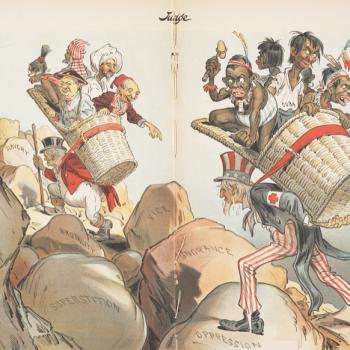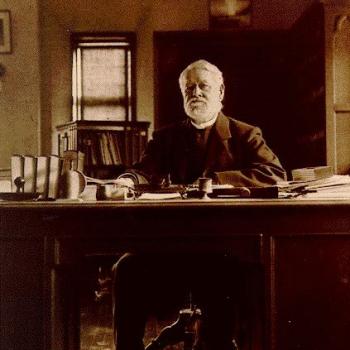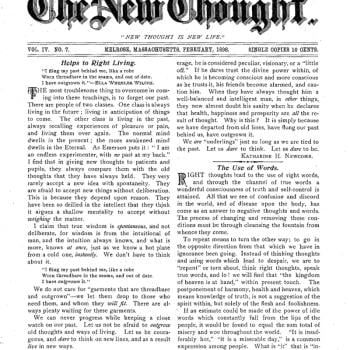I have been posting about my forthcoming book on the Global History of the Cold War. Today’s post concerns language, and some terms that I really would avoid in writing and particularly in teaching – or if I was to use them, it would be with multiple quotation marks. I’ll make the case that we should never use terms like red scare, witch-hunt, or paranoia in a Cold War context, except with those multiple caveats. And we should be very careful how we use “McCarthyism.”
I have myself used the “Red Scare” phrase in the past, and even (with some discomfort) in a book subtitle of mine from many years back. Here’s the problem. In a US context, to speak of a red scare without further qualification suggests that US concern over Communism, particularly during the 1950s, was wholly a matter of a “scare” or panic, without substance. That is simply incorrect, misleading, and tendentious. Being scared is, after all, a subjective reaction, with no necessary basis in the real world. To speak of some issue as a “scare” suggests that it exists only in the minds of some individuals, for their own particular reasons, but it is not a “real” thing. To use a modern-day analogy, many people would be very offended if someone referred to the “police brutality scare.” No, the speaker would be told, firmly. Police brutality is a very real problem, and speaking of it as a scare trivializes and delegitimizes it. Would you talk about the “global warming scare”? And that is what is wrong with the term “red scare.”
The Communist Party in the US in the 1940s commanded widespread support, and it was a wholly owned subsidiary of the Soviet government and its intelligence agencies. In the 1930s and 1940s, many thousands of Americans joined the Communist Party for a variety of reasons, many of which seem laudable today. They supported international peace and disarmament, campaigned for the civil rights of racial minorities, or favored labor movements and economic equality. In modern language, they were progressives, a label that became a Communist buzzword in the 1940s before entering the general usage that we know today. In many areas, a Communist sphere offered a wide range of social and cultural activities.
But before romanticizing these “progressive” activists, do recall that they were required on a very frequent basis to affirm, defend, justify, and actually believe a series of monstrous lies about the behavior of Communist states worldwide, their very bloody deeds, and their cynical shifts of policy. The Nazi-Soviet pact of 1939 was the best known example. It helps to think of the Communist Party (CPUSA) on the lines of a stereotypical religious cult, members of which affirm anything the leader declares, the more far-fetched the better, and however often he reverses his opinions.
And it got worse. The CPUSA was utterly compromised in its subservience to Soviet policy, and its close cooperation with Eastern bloc agencies and intelligence. The Party had a special category of clandestine members, and some worked directly with Soviet spies. The Soviets heavily funded the Party and its activities. A Soviet-oriented party genuinely was dangerous in the world as it developed after 1946, with the ever-growing likelihood of war. It was not difficult to imagine domestic Communists serving as spies or saboteurs against the US war effort. That prospect was all the more perilous given the strong Communist presence in labor unions, in key centers of war production, and major cities. It would have been impossible for any government concerned about its survival not to be investigating Communists, and removing them from key positions of influence. At the same time, there was a very delicate balance between civil liberties and the legitimate defense of national security.
I offer one specific example of a man who became a potential symbol of the “red scare” at work. Born in Croatia, Steve Nelson became a US citizen. From the 1920s, he was a leading figure in the CPUSA, and he served with distinction in the Spanish Civil War. He was a courier and later agent for Soviet intelligence, the NKVD, tasked with finding information about the Manhattan Project, and was in contact with some scientists in that project. The widow of one of his close Communist friends from Spain married J. Robert Oppenheimer, who later headed the Manhattan Project. By any reasonable standard, Nelson was a grave security threat. In 1950, at the height of the fighting in Korea, Pittsburgh authorities raided the headquarters of the Pennsylvania Communist Party, prosecuting Nelson and others for sedition. A federal trial followed, but the cases collapsed in 1957, and Nelson was ultimately freed. Through the 1950s, he was presented regularly as a victim of a bogus “red scare.” He was nothing of the kind, and we should not use any language that supports that idea. Any country that would tolerate someone like Steve Nelson had lost the will to survive.
I am bemused to see that the Wikipedia page refers to him as “Steve Nelson, activist” to distinguish him from the footballer. Oh wow… an activist! Must have been a fine man, right?
The same point applies to “witch-hunts.” We often think of Arthur Miller’s lauded 1953 play The Crucible, which ostensibly concerned the Salem witch trials of 1692, but which was commonly recognized as a thinly veiled attack on Senator McCarthy. But that witch-hunt analogy is troubling in its implication that the various investigations were attacking individuals who were blameless or innocent. Particularly in the late 1940s, the great majority of those targeted genuinely were Communists, and many were keenly active in the Party and in many associated organizations. A good number, like Steve Nelson, really were foreign agents.
Witches did not really exist. Communists did, and so did East Bloc spies, moles, and saboteurs.
If you think what I am saying here is based on empty assertion, then you really need to look at VENONA. Since the 1920s, the Soviets had operated intelligence operations in the United States. The sheer scale of those ventures was revealed by the VENONA program, which was only publicly acknowledged in 1995, and it has been the subject of much subsequent scholarship. VENONA was a successful effort by U.S. intelligence agencies, together with British, Canadian, and Australian allies, to decipher the secret communications of their Soviet counterparts from the mid-1940’s onward. The project produced a vast trove of information that pointed to legions of Soviet spies operating in the West. In virtually every case, agents were identified only by code names, but these could be penetrated easily enough by incidental information about times, places, and travels. Even so, many cables remain unbroken, and literally hundreds of agents’ names still cannot be convincingly associated with named individuals. Most died undetected and unpunished.
The VENONA documents leave no doubt about the scale of Soviet espionage in the US, and of the existence of high level defectors and agents of influence. If Franklin Roosevelt had died between 1941 and 1944, his successor would have been Vice President Henry Wallace, who had identified Laurence Duggan as his favored candidate for Secretary of State, and Harry Dexter White as his Treasury Secretary. VENONA records show that both were Soviet agents. So was President Roosevelt’s aide Lauchlin Currie. So was senior OSS officer Maurice Halperin. This suggests a degree of successful penetration at least comparable to anything the Soviets achieved in Britain, or indeed any Western country. Harry Dexter White was a key architect of the 1944 Bretton Woods agreement that laid the foundation for the post-war financial system. And yes, Alger Hiss was definitely a Soviet agent.
To use a phrase we associate with this era, the US faced a Catch-22. Through VENONA, US authorities and law enforcement knew very well about all these spies and Soviet agents on their soil. But if they revealed their knowledge, then that would destroy the VENONA program, as the Soviets would immediately realize how badly they had been penetrated, and upgrade their security. The first rule of VENONA was: you did not talk about VENONA. Hence, many of the exposés of Soviet activities had to proceed without publicizing the killer information that would have settled so many of the long-controversial cases. And that’s why a generation grew up believing that Alger Hiss and the Rosenbergs were martyrs of the Red Scare.
Here is a sobering fact. In a large proportion of the cases in the 1940s and 1950s when Americans were accused of being Soviet spies and agents, that is what they indisputably were. That also applies to suspects named and accused by some of the controversial defectors and celebrity informants of the era, who were so mocked at the time and since. If they were not infallible, those informants, including the much maligned Elizabeth Bentley, were usually right.
Red Scares, witch-hunts… and please, never talk about Cold War “paranoia.” Paranoia indicates an irrational or pathological suspicion or fear of enemies or dangers. If the enemies are real, it’s not paranoia. American anti-Communism of itself was not “paranoia,” although it could on occasion lapse into it. Nor was fear of nuclear annihilation “nuclear paranoia.” If you were not terrified of nuclear destruction at any point between, say, 1954 and 1962, you must have been living in a cocoon. By 1961, the only irrational or pathological people were the ones who thought that the world might conceivably make it through intact to the end of the decade.
And finally, be careful with “McCarthyism.” Joseph McCarthy was a dreadful and reprehensible human being, who became the highly visible face of anti-Communist inquisitions between 1950 and 1954. His investigations did disgusting things, and used unforgivable methods – although actually, far more of his targets really did have Soviet ties than we often think today. But here is the problem. If you want to denounce McCarthy and the work of himself and his committee, that is fine, and necessary. But don’t use the McCarthy label to apply to any and all investigations and exposés of Communism in the years between (say) 1945 and 1960. Many of the most important activities were carried out by responsible agencies and media, whose own politics were often liberal, centrist, or (often) Democrat. By using the “McCarthyite” label, all those investigations are stigmatized as coming from a deranged and cynical far Right, which they did not.
If we use the language of witch-hunts or red scares or paranoia, then we have already decided all the main issues and points in a discussion of the Cold War era, and in such a way that closes off debate or argument. As the phrase goes, language speaks us.













